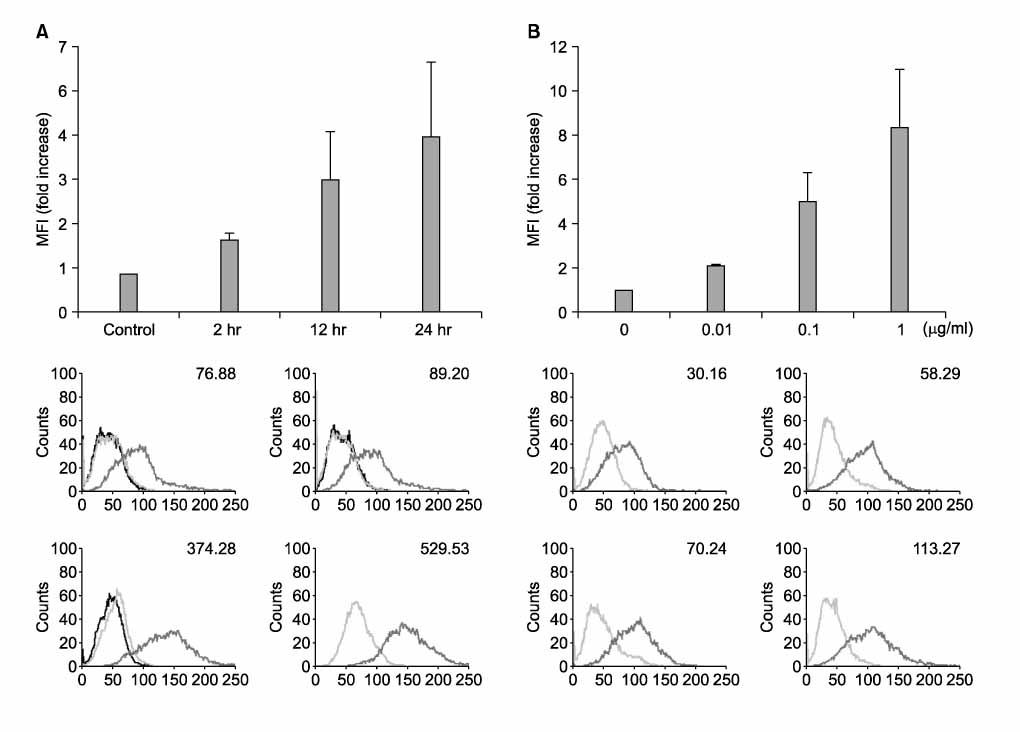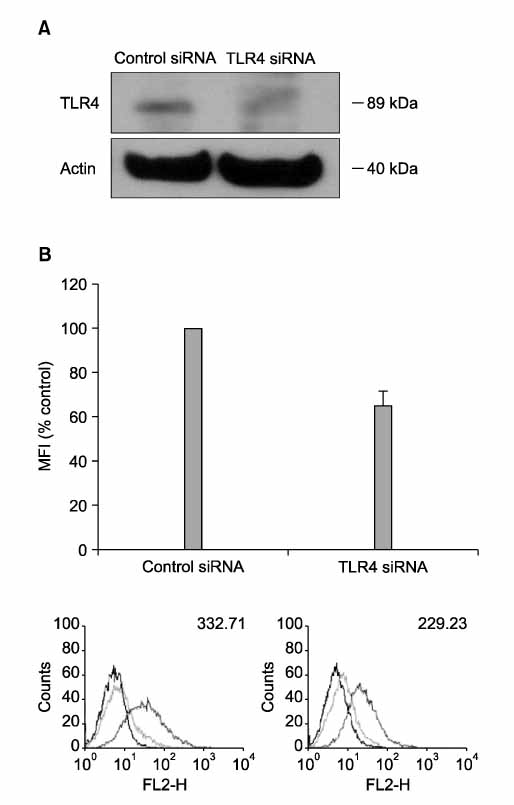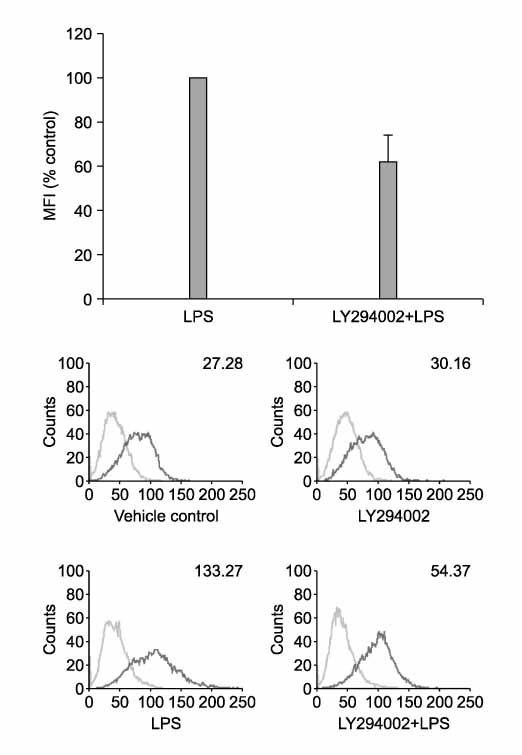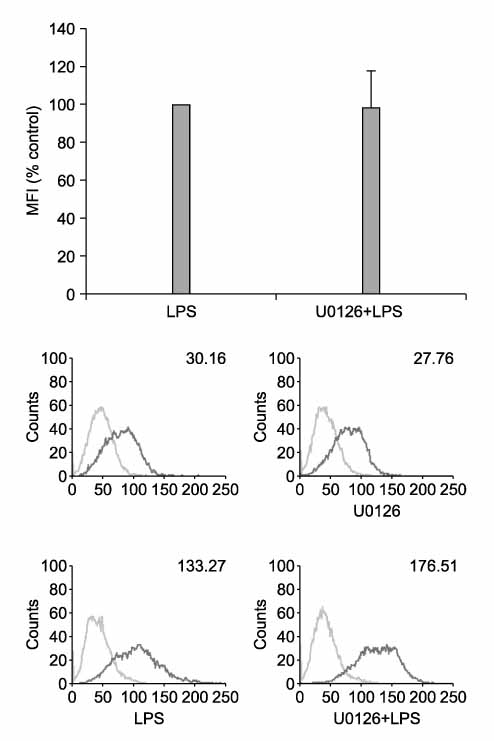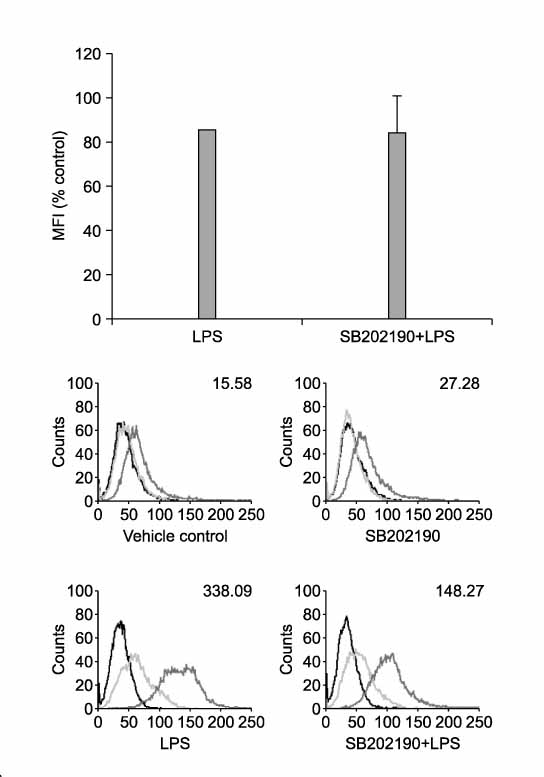Tuberc Respir Dis.
2008 Oct;65(4):343-350.
Induction Mechanism of PD-L1 (Programmed Cell Death-ligand 1) in Sepsis
- Affiliations
-
- 1Division of Pulmonary and Critical Care Medicine, Department of Internal Medicine and Lung Institute, Medical Research Center, Seoul National University College of Medicine, Seoul, Korea. sangmin2@snu.ac.kr
Abstract
- PD-L1 is expressed in a variety of antigen-presenting cells and provides T cell tolerance via ligation with its receptor PD-1 and B7-1 on T cells. Stimulation with lipopolysaccharide (LPS) can increase the level of PD-L1 expression in B cells and macrophages, which suggests that this molecule plays a role in the immunosuppression observed in severe sepsis. The aim of this study was to identify which of the downstream pathways of TLR4 are involved in the up-regulation of PD-L1 by LPS in macrophages. Flow cytometry was used to examine the expression of PD-L1 in RAW 264.7 macrophages stimulated with LPS. The following chemical inhibitors were used to evaluate the role of each pathway: LY294002 for PI3K/Akt, SB202190 for p38 MAPK, and U0126 for MEK. LPS induced the expression of PD-L1 in a time- and dose-dependent manner. Transfection of siRNA for TLR4 suppressed the induction of PD-L1. Pretreatment with LY294002 and SB202190 decreased the level of PD-L1 expression but U0126 did not. Overall, the PI3K/Akt and p38 MAPK pathways are involved in the up-regulation of PD-L1 expression in RAW 264.7 macrophages stimulated with LPS.
Keyword
- PD-L1; LPS; Sepsis; Macrophage
MeSH Terms
-
Antigen-Presenting Cells
B-Lymphocytes
Butadienes
Chromones
Flow Cytometry
Imidazoles
Immunosuppression
Ligation
Macrophages
Morpholines
Nitriles
p38 Mitogen-Activated Protein Kinases
Pyridines
RNA, Small Interfering
Sepsis
T-Lymphocytes
Transfection
Up-Regulation
Butadienes
Chromones
Imidazoles
Morpholines
Nitriles
Pyridines
RNA, Small Interfering
p38 Mitogen-Activated Protein Kinases
Figure
Reference
-
1. Angus DC, Linde-Zwirble WT, Lidicker J, Clermont G, Carcillo J, Pinsky MR. Epidemiology of severe sepsis in the United States: analysis of incidence, outcome, and associated costs of care. Crit Care Med. 2001. 29:1303–1310.2. Bone RC, Fisher CJ Jr, Clemmer TP, Slotman GJ, Metz CA, Balk RA. A controlled clinical trial of high-dose methylprednisolone in the treatment of severe sepsis and septic shock. N Engl J Med. 1987. 317:653–658.3. Bone RC. Sir Isaac Newton, sepsis, SIRS, and CARS. Crit Care Med. 1996. 24:1125–1128.4. Hotchkiss RS, Karl IE. The pathophysiology and treatment of sepsis. N Engl J Med. 2003. 348:138–150.5. Okazaki T, Honjo T. The PD-1-PD-L pathway in immunological tolerance. Trends Immunol. 2006. 27:195–201.6. Iwai Y, Terawaki S, Ikegawa M, Okazaki T, Honjo T. PD-1 inhibits antiviral immunity at the effector phase in the liver. J Exp Med. 2003. 198:39–50.7. Liang SC, Latchman YE, Buhlmann JE, Tomczak MF, Horwitz BH, Freeman GJ, et al. Regulation of PD-1, PD-L1, and PD-L2 expression during normal and autoimmune responses. Eur J Immunol. 2003. 33:2706–2716.8. Wiendl H, Mitsdoerffer M, Schneider D, Chen L, Lochmuller H, Melms A, et al. Human muscle cells express a B7-related molecule, B7-H1, with strong negative immune regulatory potential: a novel mechanism of counterbalancing the immune attack in idiopathic inflammatory myopathies. FASEB J. 2003. 17:1892–1894.9. Sharpe AH, Wherry EJ, Ahmed R, Freeman GJ. The function of programmed cell death 1 and its ligands in regulating autoimmunity and infection. Nat Immunol. 2007. 8:239–245.10. Nishimura H, Minato N, Nakano T, Honjo T. Immunological studies on PD-1 deficient mice: implication of PD-1 as a negative regulator for B cell responses. Int Immunol. 1998. 10:1563–1572.11. Nishimura H, Nose M, Hiai H, Minato N, Honjo T. Development of lupus-like autoimmune diseases by disruption of the PD-1 gene encoding an ITIM motif-carrying immunoreceptor. Immunity. 1999. 11:141–151.12. Ansari MJ, Salama AD, Chitnis T, Smith RN, Yagita H, Akiba H, et al. The programmed death-1 (PD-1) pathway regulates autoimmune diabetes in nonobese diabetic (NOD) mice. J Exp Med. 2003. 198:63–69.13. Guleria I, Khosroshahi A, Ansari MJ, Habicht A, Azuma M, Yagita H, et al. A critical role for the programmed death ligand 1 in fetomaternal tolerance. J Exp Med. 2005. 202:231–237.14. Thompson RH, Gillett MD, Cheville JC, Lohse CM, Dong H, Webster WS, et al. Costimulatory B7-H1 in renal cell carcinoma patients: indicator of tumor aggressiveness and potential therapeutic target. Proc Natl Acad Sci U S A. 2004. 101:17174–17179.15. Ohigashi Y, Sho M, Yamada Y, Tsurui Y, Hamada K, Ikeda N, et al. Clinical significance of programmed death-1 ligand-1 and programmed death-1 ligand-2 expression in human esophageal cancer. Clin Cancer Res. 2005. 11:2947–2953.16. Yamazaki T, Akiba H, Iwai H, Matsuda H, Aoki M, Tanno Y, et al. Expression of programmed death 1 ligands by murine T cells and APC. J Immunol. 2002. 169:5538–5545.17. Loke P, Allison JP. PD-L1 and PD-L2 are differentially regulated by Th1 and Th2 cells. Proc Natl Acad Sci U S A. 2003. 100:5336–5341.18. Annane D, Bellissant E, Cavaillon JM. Septic shock. Lancet. 2005. 365:63–78.19. Lee SK, Seo SH, Kim BS, Kim CD, Lee JH, Kang JS, et al. IFN-gamma regulates the expression of B7-H1 in dermal fibroblast cells. J Dermatol Sci. 2005. 40:95–103.20. Keir ME, Latchman YE, Freeman GJ, Sharpe AH. Programmed death-1 (PD-1):PD-ligand 1 interactions inhibit TCR-mediated positive selection of thymocytes. J Immunol. 2005. 175:7372–7379.21. Saunders PA, Hendrycks VR, Lidinsky WA, Woods ML. PD-L2:PD-1 involvement in T cell proliferation, cytokine production, and integrin-mediated adhesion. Eur J Immunol. 2005. 35:3561–3569.
- Full Text Links
- Actions
-
Cited
- CITED
-
- Close
- Share
- Similar articles
-
- Evaluation of circulating PD-1 and PD-L1 as diagnostic biomarkers in dogs with tumors
- PD-L1 Testing in Non-small Cell Lung Cancer: Past, Present, and Future
- Immunohistochemical expression of programmed death-ligand 1 and CD8 in glioblastomas
- Programmed cell death-ligand 1 assessment in urothelial carcinoma: prospect and limitation
- PD-L1 as a Biomarker in Gastric Cancer Immunotherapy


